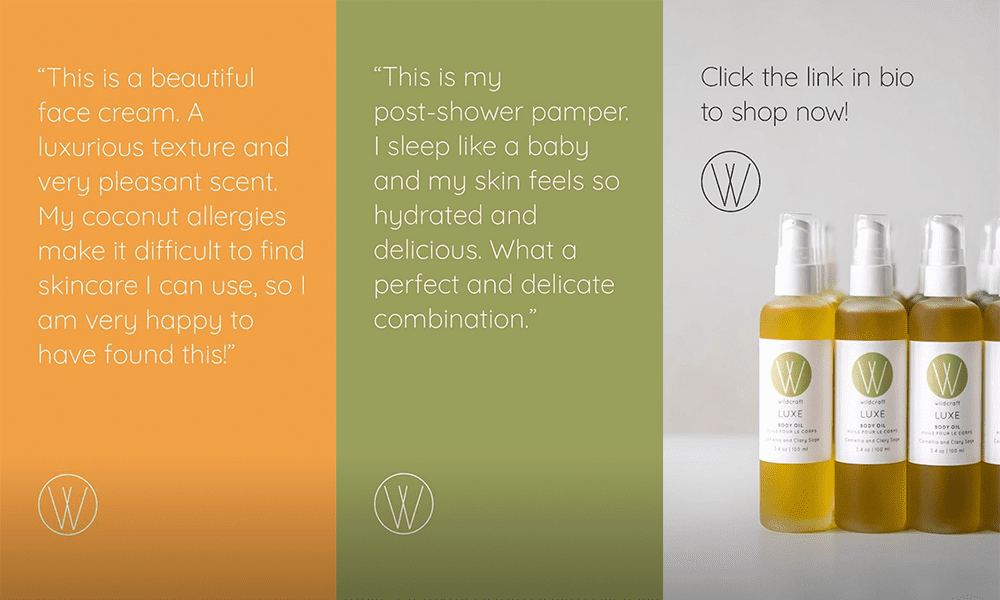As the time we spend online continues to grow, our attention spans keep dropping to rock-bottom levels. We easily get lost in our screens with an infinite stream of contentŌĆöscrolling, clicking, and swiping through feed after feed.
But what makes someone stop scrolling? What is going to grab the attention of your audience?
Enter: user-generated content. ItŌĆÖs the trustworthy stories that capture interest and provoke engagement, and these hard-to-resist stories are the ones created about brands by the audience themselves. Luckily, this user-generated content (or UGC) can be strategically used by brands to cut through the online noise.
User-generated content is considered the most honest, trustworthy, and unbiased form of content among consumers. It hugely influences behaviour and decision-making. UGC refers to any type of content that is created and shared by a brandŌĆÖs audience, users, or followers. This can mean posting pictures of their new holiday destination, featuring a product in a beauty tutorial, or creating GIFs about their favourite TV show.
In comparison to other types of content, there is one crucial element that UGC brings to your content marketing strategyŌĆötrue authenticity.
And authenticity leads to maximum attention.
According to the latest UGC platform TINT, over 90% of consumers are more likely to trust a recommendation from a friend than branded content. And StacklaŌĆÖs Consumer Content Report shows that people are 3X more likely to say that content created by a fellow customer is more authentic compared to branded content.
Authentic content leads to greater trust with your audience. In turn, it creates higher brand recognition and loyalty for your business.
How UGC benefits your business

Before we talk strategy, itŌĆÖs important to understand how UGC adds value to your business. Sharing brand-loyal customer content does more than keep your companyŌĆÖs social accounts fresh. UGC is a huge game changer if it’s leveraged properly. Here are five canŌĆÖt-miss benefits of UGC for your brand:
- Generate trust. When your audience sees others just like them interacting with your brand, it generates social proof, builds trust, and boosts the credibility of your business.
- Gain audience insight. UGC contains a gold mine of data that allows you to better understand your audience and get their honest opinions on what matters most.
- Increase your social reach. People might promote your brand for self-expression, but their content exposes your product or service to potential customers. UGC is a key opportunity to tap into unexplored sections of the market and boost conversions.
- Raise your SEO ranking. Backlinks to your website on your fansŌĆÖ blogs and social accounts will lift your SEO rankingŌĆöalong with positive customer reviews. ItŌĆÖs also a perfect chance to optimize your keyword research based on the wording your audience frequently uses.
- Stretch your budget. Sourcing content directly from your fans has little to no cost involved and itŌĆÖs less time-consuming than creating content yourself.
Checklist: best practices to consider before sharing UGC

If youŌĆÖre planning to include user photos on your website or repost an Instagram video your brand is tagged in, consider these key best practices upfront.
As tempting as it might be to quickly hit the share button, user-generated content can trick you into complex copyright issues and potential legal steps (and no one wants that).
Are you able to tick off the below checklist?
Best Practice #1: Add value┬Ā
Be strategic and mindful of blending UGC into your content stream. How does it serve your followers, strengthen your marketing efforts, and honour your brandŌĆÖs mission? Including user-created content that reflects your audienceŌĆÖs passions (or concerns) will intensify the sense of community and deepen your brand values on your online platforms.
Best Practice #2: Always ask for permission
Re-sharing content without explicit permission could wipe out all of your marketing efforts in one single click. Make sure you always seek permission from those who created the contentŌĆöwhich isnŌĆÖt necessarily the one who uploaded the content. Do some sleuthing to uncover the original content creator.
Best Practice #3: Credit the original source┬Ā
Once you have permission, double-check that youŌĆÖre giving clear credit to the original creator. Specify whether you are using their words, visuals, or both. Tag them directly in your post and caption with their name and/or social account. By providing solid credit for user contributions, youŌĆÖre recognizing their work and encouraging others to post about your brand.
5 types of UGC to easily integrate in your content strategy right away
UGC comes in all shapes and sizes, so weŌĆÖve gathered some inspiring examples from Canadian businesses. Here are the ones that master the craft of marketing their brand with the voice of their fans.
1. Share product reviewsŌĆöWildcraft┬Ā

Product ratings, customer testimonials, and case studies on your companyŌĆÖs site will increase the reliability of your products or services. Natural skincare company, Wildcraft, has integrated a product review feed on each product page of their website. They also use the Story Highlights on their Instagram page to feature photos, videos, blog posts, and quotes of customer reactions about their products.
Why we love it: Reviews help customers find the perfect fit for their needs, and to gather honest judgment before making a purchasing decision. Sharing your customersŌĆÖ feedback also creates a community of brand advocates.
2. Bring your customers into the storyŌĆöLululemon

Why we love it: Lululemon tapped into a cause, brought their customers into the story, and offered them a stage to express their experiences and needs. To deepen the relationship with their customers, they brought the #boobtruth experience offline at LululemonŌĆÖs SeaWheeze. At the event, visitors received their customized Signature Movement for the best-fitting sports braŌĆöa smart move that allowed Lululemon to collect data and insights on how to create better products for their customers.
Lululemon created momentum for the launch of their Signature Movement in-store experience by embracing ŌĆśreal talk.ŌĆÖ They released their Boob Truth series on IGTV. This has stigma-breaking and thought-provoking interviews with different women who openly talk about their breasts. With a branded hashtag, Lululemon invites fans to express their #boobtruth for a chance to be featured in an episode.
3. Feature customer photos on your websiteŌĆöCanadian Museum of Nature

Many museums open their doors to host a variety of public and private events. With its aesthetic backdrop, the iconic Canadian Museum of Nature is a much sought after wedding location. The museum gets the wedding bells ringing by featuring photos of newlyweds on their rental webpage with their hashtag #weddingatthemuseum.
Why we love it: as online experiences become more visual thanks to social networks like Instagram, customers now expect to see similar content on your website as well. Weddings are known for being heavily photographed and shared online. The Canadian Museum of Nature moved away from static images of empty rooms and instead, they use authentic customer photos. This creates a social stream on their website for soon-to-be married couples to experience what their future wedding venue can look like.┬Ā
4. Host a UGC-focused contestŌĆöSAXX┬Ā

Underwear company SAXX teamed up with Movember to host the Undie Run. Hundreds of men (and women) ran through the streets of Vancouver and Toronto in their underwear to raise awareness and funds for menŌĆÖs health research.
SAXX encouraged their community to spread the word about the run with a little healthy, UGC-led competitionŌĆöworth a week of SAXX underwear. Fans took on the challenge to share the most creative post about their participation in #theundierun.
Why we love it: people are strong advocates for brands that stand for a cause. By adding a charitable component to the campaign, SAXX created visibility to a serious issue while having fun doing so. The campaign was not only a great way to drive awareness and engagement, but also to raise funds for charity.
5. Create brand desireŌĆöDestination British Columbia

Destination British Columbia is a pioneer when it comes to user-generated content. Their hashtag #ExploreBC has been used over five million times on Instagram alone! By using geotags and branded hashtags, Destination BC gives travellers all the inspiration and tools they need to start planning their trip, resulting in leads to destinations around the province.
Why we love it: Destination BC transforms inspirational content into a functional way for people to plan their own adventures. The brand capitalizes on peer-to-peer advocacy and takes social content beyond the borders of social media by integrating UGC into their overall marketing campaigns.
Here are the insights, best practices, and new inspiration you need to create an amazing UGC strategy of your own.
Ready for more advice on how user-generated content can power up your content marketing and generate maximum attention for your brand? WeŌĆÖd love to have a conversation with you about your strategy. Schedule a time to talk or send us an email at hello@forgeandspark.com.













